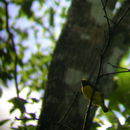fi
nimet breadcrumb-navigoinnissa


Perception Channels: visual ; tactile ; acoustic ; chemical
US Federal List: no special status
CITES: no special status
IUCN Red List of Threatened Species: least concern
None specified
The yellow-crowned euphonia is well-known and popular on birding expeditions throughout its geographic range. It is also a popular cagebird.
As with all species of euphonia, E. luteicapilla is a frugivore, mostly feeding on mistletoe berries but also on other tree borne fruits. Its gut is actually specially adapted for mistletoe berries, which are a poisonous fruit.
(Slud 1964; Wetmore 1989)
The yellow-crowned euphonia can be found from Nicaragua to Panama.
(Slud 1964)
Biogeographic Regions: neotropical (Native )
Euphonia luteicapilla are common in dry scrubby and shrubby areas, savannas, and clearings with scattered trees. It can be found on occasion in the canopy of small forests.
(Ridgely 1984; Slud 1964; Wetmore 1989)
Terrestrial Biomes: savanna or grassland ; forest ; scrub forest
Euphonia luteicapilla is a very small bird, ranging in length from 86-96 mm. The male's entire crown and most of his undersurface are bright yellow. The throat and rest of its upper parts are steel blue. Females are a yellowish olive color on their upper surface and have an underside of dull yellow. The bill of E. luteicapilla is relatively small. It has a broad shape that gradually tapers to a point. Halfway down the beak there is a slight bend downwards.
Though this species is not well studied, according to Wetmore a female was caught and measured at 13.2 grams.
(Ridgely 1984; Wetmore 1989)
Other Physical Features: endothermic ; bilateral symmetry
Euphonia luteicapilla builds covered nests with a side entrance. This habit is unique among its family. Both male and female help to build the nest.
Clutches are usually between 2 and 4 eggs, most often 3 are present. Only the female incubates the eggs, which usually hatch in 13 or 14 days. Regurgitated matter is fed to the hatchlings by both parents. Young are able to leave the nest in 22 to 24 days. If it is still early enough in the breeding season, a second brood may be raised.
(Ridgely 1984; Wetmore 1989)
Key Reproductive Features: iteroparous ; gonochoric/gonochoristic/dioecious (sexes separate); sexual ; oviparous
The yellow-crowned euphonia (Euphonia luteicapilla) is a species of bird in the family Fringillidae. It is found in Costa Rica, Nicaragua, and Panama, and is perhaps the most common euphonia in its range.[2] Its natural habitats are subtropical or tropical dry forest, subtropical or tropical moist lowland forest, and heavily degraded former forest. It can be found on occasion in the canopy of small forests.[3]
The males have an entirely yellow crown and dark throat. The females have no yellow crown and are yellowish olive color on their upper surface and have an underside of dull yellow. They're mostly indistinguishable from other euphonia, but often seen in pairs or small groups with males.[3][4]
The yellow-crowned euphonia (Euphonia luteicapilla) is a species of bird in the family Fringillidae. It is found in Costa Rica, Nicaragua, and Panama, and is perhaps the most common euphonia in its range. Its natural habitats are subtropical or tropical dry forest, subtropical or tropical moist lowland forest, and heavily degraded former forest. It can be found on occasion in the canopy of small forests.
The males have an entirely yellow crown and dark throat. The females have no yellow crown and are yellowish olive color on their upper surface and have an underside of dull yellow. They're mostly indistinguishable from other euphonia, but often seen in pairs or small groups with males.
 Female. Canopy Camp - Darien, Panama
Female. Canopy Camp - Darien, Panama